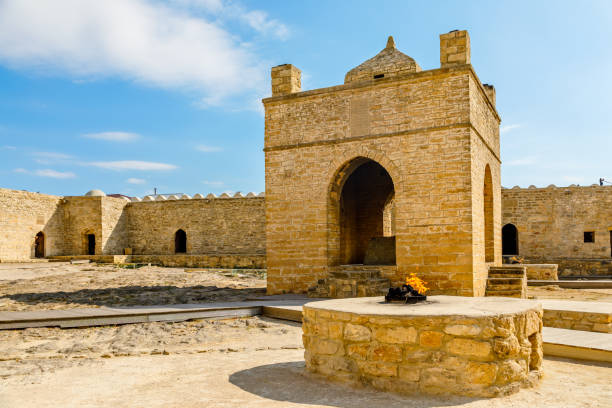Fire Temple Baku – Atesgah
Where the flame “plays” with the wind
According to historical sources, “Ateshgah” is a sacred shrine built in the 17th-18th centuries on the site of eternal, unquenchable flames from which natural gas was released. The earliest construction of the temple is attributed to approximately 1713 AD. The central temple shrine was built in 1810 with the funds of the Indian merchant Kanchanagara.
Ateshgah has located a short distance from the sea, in the southeast part of the Surakhani village on the Absheron peninsula, near the oil fields.
Currently, this place is surrounded by oil wells from all sides. The relief of the place where the monument is built is plain. According to historians, the cells and the chapel were built at different times during the 17th-19th centuries. The cells were fenced in at the end of the 17th century. It is believed that “Ateshgah” was built by the Indian community who came to Baku and settled here and originally belonged to the Sinkh sect from northern India.
The construction of Ateshgah,
reminiscent of medieval caravansaries, is in the form of a closed pentagon and consists of 24 cells and one room, which were once used for serving pilgrims. In the middle of the courtyard formed by closed pentagonal walls, there is a chapel in the form of a rotunda. The natural gas (methane) coming out of the well in the middle of the temple once burned day and night.
During the construction of the fireplace, stone bowls were installed on the four corners of the dome of the temple. The Temple of Fire itself, which has a classic quadrangular shape, is surrounded by entrance doors that are open from all sides. An inscription in Hindi is installed on the arch on the northern wall of the temple in the direction of Balakhani village. There are similar inscriptions engraved in the Indian alphabet on the entrance of other cells. Out of twenty such inscriptions, only one is in Persian.
On the northeast side of the temple, there is a square Chala, which is completely filled with stone. It is believed that the bodies of Indians who died here were burned in the “holy fire”. There is another well filled with stone on the southeastern side of the fire pit. Researchers believe it is a water well.
In general, Surakhani “Ateshgah” consists of the main temple itself, the cells of the Indian monks, and rooms for pilgrims. According to some historians, Ateshgah was built by local craftsmen based on the Indian plan. Ateshgah, which does not match the existing elements and stylistics of pre-Islamic oriental architecture, has attracted the attention of travelers, writers, artists, and scientists in all periods.
An interesting fact is that this Temple of Fire is home to chemist-scientist Mendeleev, famous Russian artist Vereshchagin, French writer Alexander Dumas (father), Nobel brothers, Jawaharlal Nehru, Indira Gandhi, world-famous film director Raj Kapoor, orientalist-scientist Dorn, and many other famous personalities. attracted to him. Duma, who was very surprised by what he saw in the Surakhani Fire Station, described this Fire Temple with a very emotional and amazing pen in his work “Caucasus Trip”.
He wrote about it like this: “When going from Baku to Ateshgah, the holy temple of fire worshipers, more than half of the road was along the sea shore. It took us two hours to reach the apartment. When he climbed the hill, an unimaginable strange sight opened in front of him. Buildings in the firing range and hundreds of large and small trees blowing smoke and flames seemed like a handful. As the wind blew, the tongues of burning flame seemed to dance strangely, sometimes they boiled like a spring, sometimes the wave attacked from one side and rose to the branch, and sometimes it rose unexpectedly. It seemed as if the wind was playing with the fire, they were wrapped around each other, and then they fell into each other’s arms. No matter how hard the wind tried, it could not extinguish the fire.”
Indian Firefighters
Zoroastrianism was dealt a crushing blow during the period of Arab expansion that began in the 7th century with the formation and spread of Islam and lasted for three hundred years. Firefighters are persecuted, and ceasefires are broken. It is assumed that the ancient Temple of Fire, which occupied the place of the current Ateshgah, was also destroyed during the Arab invasion. As a result of the development of economic and cultural relations with India after the 15th century, Indian fire worshipers came back to Absheron and restored the Surakhani Fire Station. According to information from medieval sources, in the 18th century, rich fire-loving Indian merchants built the present Fire Temple and cells for Indian pilgrims in Surakhani, on the site of the ancient fire before Islam. they tried to destroy their physical bodies.
It is also clear from the contents of the inscriptions in Ateshgah that Surakhani fire worshipers were of Indian origin. Ateshgah itself reached its highest progress in the 18th century. It is interesting that the current cells were fenced at the same time. It is clear from historical sources what the holy pilgrimage to Mecca and the Hajj means to the Muslims of the world, the Surakhani Ateshgah once played the same role in the life of the fire worshipers. According to researcher-scientist Sharden, in the 60s of the 18th century, the Surakhani Fire Temple was visited mainly by Indian fire worshipers, but also from the Near and Middle East, Iran. Fire-loving Persians also came to visit from Afghanistan.
From the Persian inscription in cell No. 8 of Ateshgah, it is clear that in 1745, Iranian Zoroastrians were regular visitors to the fire temple. In 1950, the Indian scholar Mahaphaputra Unvala read the 16 inscriptions in Ateshgah, including the one written in Persian, according to his proposed method and took photographs of the monument, and published them in various media.
Five inscriptions of Surakhani Fire Station were sent to India by historian-scientist V.Sisoyev and were read there. Those inscriptions were translated from English to Russian and published in 1946. English traveler Jackson noted 18 inscriptions in Ateshgah. Fifteen of them are dedicated. The first inscription dates back to 1713, and the last one to 1827. According to official information, most of the Indians living in Ateshgah came from northern India – Lahore, Tennessee, Kachbudi, Multan, and other places. They spoke Hindi among themselves. Indians, who used the financial aid of their countrymen – Indian merchants, spent their days comfortably watching the sacred fire.
Brahmins were in charge of worship. In 1860, academician B. Dorn visited Ateshgah. At that time there were five Indians in the temple. One of the local residents of Baku, B. Dorn, informed that the Indians were divided into four sects: the followers of the first sect burned their dead in the fire (atashi), the second set blew their ashes to the wind (badis), the third ones poured the ashes into the water (abis), and the fourth ones buried the corpses in the ground (khakis). . In 1880, the last Indian left alone in Ateshgah left Absheru and returned to his homeland – India.
Miracles of the temple
According to some researchers, the construction of the Temple of Fire dates back to BC. Currently, there is such a ceasefire in only two places in the world – North India and Azerbaijan. The highest worship and worship temple of fire worshipers is the Surakhani Fire Station in Azerbaijan.
When entering Surakhani Ateshgah, one of the oldest sanctuaries in the world, one feels that the voice of ancient spirits is coming from here. The late psychic Etibar Elkin said that this is the most sacred place in Azerbaijan and is guarded by many spirits. It is clear from the conversations that every tourist who enters the cells of Ateshgah can clearly feel the strangeness, or rather, the miracles in this place. For example, when you enter the 12th cell and look at the flame burning in the dome of the quadrangular building in the courtyard of Ateshgah, you witness a very strange sight.
At this time, it seems to a person that you are standing one step away from the flame. Or, after entering cell 18 and standing here for a while, you hear strange sounds. It seems to the person that someone is talking. The muffled voices are clearly heard, but what they are saying is not understood.
According to one of the local residents, everyone who enters Ateshgah feels the difference in the atmosphere here. In every cell in the yard, it is possible to hear the aura of fire worshipers who once lived and died in the bar, which has an extraordinary effect. Even today, the bathtub-like stone pit where dead fire worshipers were cremated creates extraordinary emotions. According to experts, sensitive and emotional people witness a number of strange things when they visit Ateshgah. From the conversations, it is clear that even ordinary pets behave strangely in the courtyard of this Fire Temple.
Belief
It is said that once one of the guests who came to Fire Temple Ateshgah was walking through the cells and a cat appeared somewhere in the doorway. This common everyday pet looks at the visitor with a very strange and terrifying look and starts making incomprehensible sounds. And then he suddenly disappears as if he wanted to pounce on the guest. The bewildered guest says that he has never met a cat that makes such noises in his life and says that it is related to the spirits in Ateshgah.
Respect for history, care for the past…
It is no coincidence that the Absheron Peninsula, which is one of the unique tourist corners of the world, and the material and cultural monuments with ancient history in this place leave a strong impression on the rich past and unique culture of our nation on every foreign visitor to Azerbaijan. In this regard, the decree signed by the President of the Republic Ilham Aliyev on December 19, 2007, regarding the declaration of the Ateshgah area in Surakhani as the “Temple of Ateshgah” State historical-architectural reserve is of great importance. The preamble of the said state document states:
“Natural eternal fires burning in Azerbaijan since ancient times had a strong influence on people’s religious beliefs and created the belief of worshiping fire. One of the places that people considered as a temple was the territory of the current Ateshgah temple in the Surakhani district of Baku city.
Fire temple was built in the 17th-18th centuries on the remains of the ancient temple of fire worshipers, in the place of the eternal torch from which natural gas was emitted, this temple consists of 26 cells and a central shrine. Currently, the Ateshgah Temple operates as a branch of the State Historical-Architectural Reserve-Museum “Shirvanshahs Palace Complex”, but its specificity, uniqueness, and inclusion in the Preliminary List of UNESCO’s World Heritage make it necessary for the independent activity and protection of the “Ateshgah Temple” monument. it is also a manifestation of respect for our great history and care for our rich past.
Currently, “Ateshgah” with an area of 1368 square meters or 0.14 hectares has been operating as a museum since 1972, but after its restoration in 1975, it became a branch of the State History-Architecture Museum-Reserve. As before, hundreds of tourists come here every year. Among them, there are representatives of different religions. It is not tourist interest that brings most of these people to Ateshgah. They also visit this holy place – the Temple of Fire, like their great ancestors, and pray to fire, and benevolent spirits. During the Nowruz holidays, Muslims who come here also make sacrifices. As a unique masterpiece and a national material treasure, the Surakhani Campfire remains the first of two rare campfires in the whole world, which provides the most detailed information about the followers of Zoroastrianism, an ancient religion.

